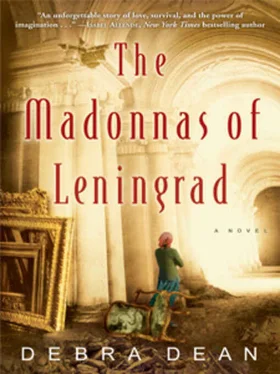“Now, usually Bacchus was portrayed as a slim and handsome young man, but Rubens shows him here as very fat. Imagine a very fat, naked man with flesh piled in rolls on his huge belly. This was painted at the end of Rubens’s life, when he was so sick with gout that he could hardly grasp a brush.”
The boys trade glances between themselves.
“Excuse me, comrade-what is gout?”
Of course these boys have never heard of such a thing. “It is the disease of the decadent bourgeoisie, caused by indulging in too much rich food and wine. Catherine the Great also had gout. It caused the extremities to swell painfully. Here Rubens has given Bacchus gout, as well. He is seated on a wine cask because his toes are too swollen for him to stand.”
One of the boys raises his hand and asks, “Is his female comrade naked also?”
“Well, no,” Marina answers, keeping her face straight, “she has only one breast exposed, but that is an astute question, because Rubens’s women are often unclothed. He was the undisputed master at painting skin and making it look real, and so he was famous for his nudes.”
“Are they pretty?” another boy asks.
“I think they are quite beautiful.”
As she moves down the wall, she points out Venus and Cybele, and the boys focus intensely, as though willing the naked women to appear.
In the next room, she stops in front of another vacant frame.
“Oh, I like this one very much. It is called Saint Luke Drawing the Virgin . There were so many paintings of the Madonna in the museum, but this one is particularly clever because it is not so much about the Madonna as it is about the artist and art itself.
“The people who commissioned van der Weyden wanted an official painting for their guild, which was like a union. They said, ‘Paint us a picture with the Madonna.’ So over on the left here, holding her child, is Mary.” Marina describes a woman wearing a dark, rather plain gown, very similar in color to the dark background.
“But the artist didn’t want to paint just another Madonna, because this was such a commonplace subject, so he cleverly put himself into the picture, disguised as Saint Luke, the patron saint of artists. A patron saint,” she adds, “is the dead person that believers prayed to for help.” With the flat of her hand, she sketches the space on the right that the figure occupied. “He is over here, holding a small canvas and a brush. But not only has van der Weyden put himself in the picture, but he’s dressed in bright red, from his head to his toes. So our eye is drawn to him rather than to Mary.
“And then our eye moves here, to the center of the painting. Do you see these two smaller figures in the background?” She catches herself, realizing that she is pointing to a blank square, but the boys and their teachers are all completely focused on the spot where she has directed their gaze. “There are two figures, a man and a woman. They are standing outside, past the studio where the artist is painting his model, and they’re gazing away from the viewer at the landscape beyond. They’re posed between two dark pillars that open onto a light-filled landscape. Our eyes follow theirs to the view of the peaceful river. It zigzags through a beautiful medieval city and off into this very soft, luminous horizon.”
She is awed by the vision and doesn’t say anything for a moment. They all stare at the wall in silence.
“So,” she resumes, “the artist was saying to us that this isn’t really about a Madonna. The real miracle is the painting itself, which lifts us and carries us away to this magical world.”
And then she is walking again, backtracking through the rooms. “I have something else wonderful to show you,” she promises. She marches them briskly through the empty Snyders Room, calling up in her memory and then reluctantly rejecting canvas after canvas. They are wonderful-enormous market scenes teeming with dizzying heaps of fish and baskets of produce-but it would be cruel to describe such pictures to starving boys. Similarly, she skips past the frames that held Fyt’s still lifes, with their artful arrangements of dead game and glistening fruit.
They pass into a dark passage lit only by Marina ’s kerosene lamp. At the start of the war, the Raphael Loggias, a glassed arcade with exquisitely detailed frescoes covering every surface, were boarded over from the inside and sandbagged up to the top of the windows. The frescoes were left in place, though, and as they move down the darkened tunnel, fantastic images emerge from the shadows, wavering in the dim light and then receding again. Painted squirrels climb columns decorated with elaborate scrolls of oak leaves. Greek athletes strike poses in medallions on the walls.
“This loggia is five hundred years old. It is an exact copy of the original in the Vatican, which was painted by Raphael and his students. This style of ornamentation was seen in classical Rome and was called grotesques.”
Every surface is crowded with animals and fruits, with real and imaginary creatures-a porcupine, a crow, a unicorn and a satyr, lions’ heads and equestrian mounts and winged angels-an illustrated encyclopedia of the world. The lamplight flickers in water-darkened mirrors, and as they pass, their own images jump out at them. Above, in a succession of vaults, loom sea-dark scenes from the Bible.
At the end of the loggia, they emerge into another denuded room. She draws them into a half circle around the first in a row of freestanding panels.
“This is the spot that held one of the most prized paintings in the entire Hermitage collection. The painting is called The Holy Family , and it was painted by Raphael.”
Marina gazes at the panel. “I don’t know that I will be able to do it justice,” she admits. “It’s such a wondrous painting because Raphael took these mythical characters, the Virgin Mary and Joseph and the Christ Child, and he reimagined them as real people, an actual family. If they were real, they wouldn’t be gilt and perfect. And so what he came up with was this rather melancholy little family portrait. On one side,” she says, pointing, “we have Mary. She is beautiful but very distant and unaware. And quite apart from her, over here, is Joseph. He’s much older than Mary. He leans on his walking stick and looks almost frail. Between them”- Marina points to the exact center of the blank square-“standing on his mother’s lap, is the Christ Child. He’s a mama’s boy. He is eyeing Joseph fearfully and his arms are reaching out for his mother. Joseph’s expression, I think, is one of resigned disappointment, a father whose child rejects him for the mother.”
The boys are staring at the blank square, their eyes unfocused and dreamy.
“They have halos,” an older boy murmurs.
“Why yes, they do,” Marina responds, a little taken aback. “You have been here before?” she asks him.
The boy’s eyes drop to the floor. “No, comrade,” he murmurs. “It is just…” he points to the framed space, unable to complete his sentence.
Marina is puzzled, but she continues. “One wouldn’t notice the halos at first, but they are there, fine as piano wires. It’s almost as though Raphael was saying that what sets them apart from any other family is almost invisible. They might be us.
“Now, over here was Raphael’s Conestabile Madonna.” She leads them to another panel, this one very ornate and gilded like the proscenium arch of an old theater. There is nothing in the center where the stage would be except a darkened square of paint.
“The Conestabile Madonna was one of only three paintings that were packed with their frames. Which is too bad for us, because the frame itself was quite beautiful and elaborate.” She describes the frame and then works her way in to the round canvas at the center. “Everything in the painting has been arranged to fit inside the circle,” she says. “The Madonna’s head is slightly inclined”- Marina demonstrates by tucking her chin just so-“and the shore of the lake and the distant mountains curve into the center.”
Читать дальше












